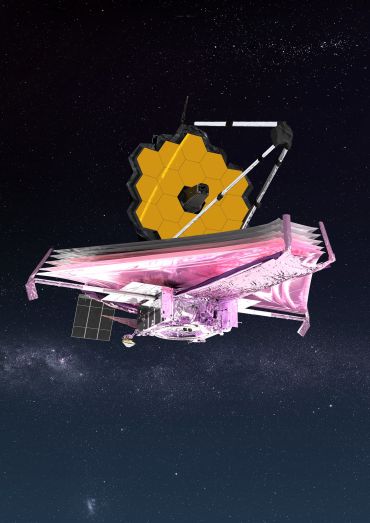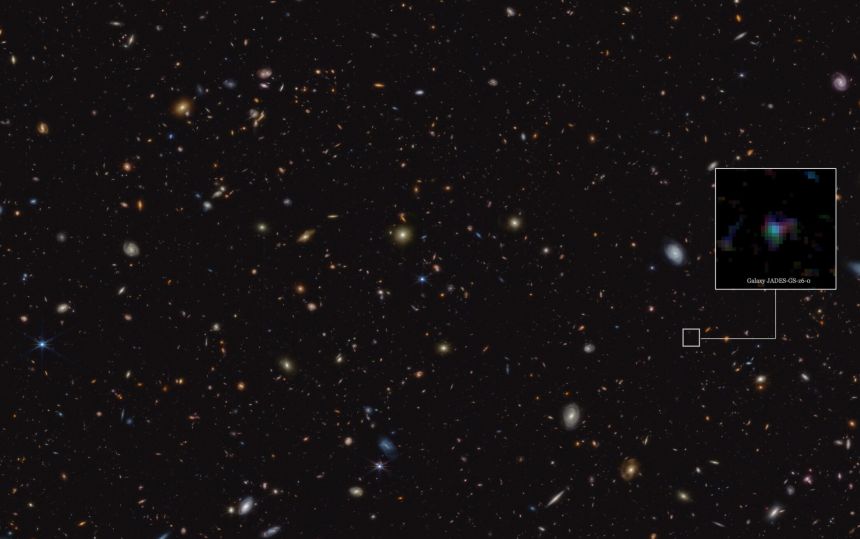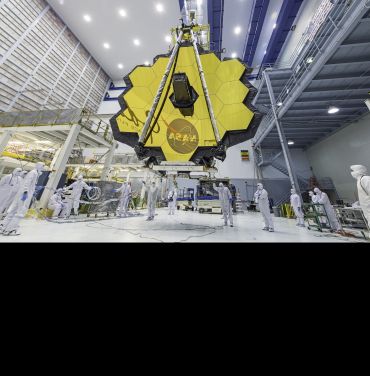James Webb Space Telescope detects interstellar dust grains in the first billion years of cosmic time
Wednesday 19th Jul 2023, 12.40pm
 Artistic conception of the James Webb Space Telescope. Credit: NASA GSFC/CIL/Adriana Manrique Gutierre.
Artistic conception of the James Webb Space Telescope. Credit: NASA GSFC/CIL/Adriana Manrique Gutierre.
The seemingly empty spaces in our Universe are in reality often not empty at all, but occupied by clouds of gas and cosmic dust. These dust grains, produced through various processes such as supernovae explosions, play a crucial role in the evolution of the Universe, acting as the birthplaces for new stars and planets. However, until now, technological limitations restricted astronomers to studying cosmic dust associated with galaxies which formed a long time after the Big Bang (when the Universe was at least a billion years old).
With the advent of the JWST, astronomers have now been able to analyse the composition of cosmic dust during the first billion years of cosmic time, when the initial stages of galaxy evolution took place. This was made possible by JWST’s ability to make very detailed observations of the light from individual dwarf galaxies.
Professor of Astrophysics Andy Bunker (Department of Physics, University of Oxford), a co-author for the study, explained: ‘Astronomers can acquire information about the composition of cosmic dust by observing the wavelengths of light that it blocks. For instance, we know that carbon-rich dust grains can be particularly efficient at absorbing ultraviolet light with a wavelength of around 217.5 nanometres. For one particular galaxy, the analysis showed a prominent dip in the light around this wavelength, which indicates that dust grains made of carbon molecules are present in the gas within this galaxy.’
Similar signatures have been observed in the much more recent Universe, including our own Milky Way galaxy, and have been attributed to complex, carbon-based molecules known as polycyclic aromatic hydrocarbons (PAHs). Modelling studies predict, however, that PAHs would require several hundreds of millions of years to form, making it unlikely that they were present within the first billion years of cosmic time. Therefore, this new observation suggests the exciting possibility that the JWST may have observed a different species of carbon-based molecule, for instance minuscule graphite- or diamond-like grains.
Potentially, these may have been produced by early supernovae explosions or Wolf-Rayet stars: very hot stars that tend to live fast and die young, giving enough time for generations of stars to have distributed carbon-rich grains into the surrounding cosmic dust in under a billion years.
 This image highlights the location of the galaxy JADES-GS-z6, where the observation of carbon-rich dust grains was made. JADES-GS-z6 is located in a portion of an area of the sky known as GOODS-South, which was observed as part of the JWST Advanced Deep Extragalactic Survey (JADES). or JADES. Credit: ESA/Webb, NASA, ESA, CSA, B. Robertson (UC Santa Cruz), B. Johnson (Center for Astrophysics, Harvard & Smithsonian), S. Tacchella (University of Cambridge, M. Rieke (Univ. of Arizona), D. Eisenstein (Center for Astrophysics, Harvard & Smithsonian), A. Pagan (STScI).
This image highlights the location of the galaxy JADES-GS-z6, where the observation of carbon-rich dust grains was made. JADES-GS-z6 is located in a portion of an area of the sky known as GOODS-South, which was observed as part of the JWST Advanced Deep Extragalactic Survey (JADES). or JADES. Credit: ESA/Webb, NASA, ESA, CSA, B. Robertson (UC Santa Cruz), B. Johnson (Center for Astrophysics, Harvard & Smithsonian), S. Tacchella (University of Cambridge, M. Rieke (Univ. of Arizona), D. Eisenstein (Center for Astrophysics, Harvard & Smithsonian), A. Pagan (STScI).
Co-author Dr Aayush Saxena (Department of Physics, University of Oxford) added: ‘The formation processes of interstellar dust are uncertain, but it is generally believed that supernovae (exploding stars) and evolved stars play a major role in the dust production. These unique observations, however, point towards a much quicker dust production channel, perhaps related to stellar winds in very young and massive stars. This might alleviate the tension among observations of dust in the very early Universe and dust production timescales.’
According to the researchers, further investigations into this observation will likely yield valuable new insights into the evolution of stars and galaxies during the first billion years of cosmic time. Co-author Dr Jacopo Chevallard (Department of Physics, University of Oxford) said: ‘Interstellar dust plays a major role in several astrophysical processes: dust grains provide the surface on which the complex chemical reactions necessary to form organic molecules take place; dust grains also form the basic building blocks of proto-planetary disks, from which planets form. Characterising the origin and properties of dust at these very early times has therefore major implications for our understanding of organic chemistry and planet formation in the early Universe.’
 The James Webb Space Telescope’s 18-segmented gold mirror at NASA’s Goddard Space Flight Center in Greenbelt, Maryland. The mirror was specially designed to capture infrared light from the first galaxies that formed in the early universe. Image credit: NASA/Desiree Stover.
The James Webb Space Telescope’s 18-segmented gold mirror at NASA’s Goddard Space Flight Center in Greenbelt, Maryland. The mirror was specially designed to capture infrared light from the first galaxies that formed in the early universe. Image credit: NASA/Desiree Stover.
The study was made possible due to JWST’s near-infrared spectrograph (NIRSpec) instrument, which was contributed by the European Space Agency. NIRSpec has unprecedented sensitivity of near-infrared light, enabling large-scale spectroscopic surveys of up to almost 200 astronomical objects simultaneously. The instrument’s science team is based across six leading European universities, including the University of Oxford.
These observations were made as part of the JWST Advanced Deep Extragalactic Survey (JADES), which devoted about 32 days of telescope time to uncovering and characterising faint, distant galaxies. This programme has facilitated the discovery of hundreds of galaxies that existed when the Universe was less than 600 million years old, including some of the farthest galaxies known to date. The Oxford astronomers were responsible for determining which distant galaxies to take spectra of using the NIRSpec instrument, and led the survey paper presenting all the galaxies observed in the deepest, most sensitive part of the JADES survey.
Co-author Dr Alex Cameron (Department of Physics, University of Oxford), said: ‘This is a really nice example of the power of this new instrument and the JADES survey, where suddenly we can probe distant galaxies in ways that simply weren’t possible before.’
The study ‘Carbonaceous dust grains seen in the first billion years of cosmic time’ has been published today in Nature.

